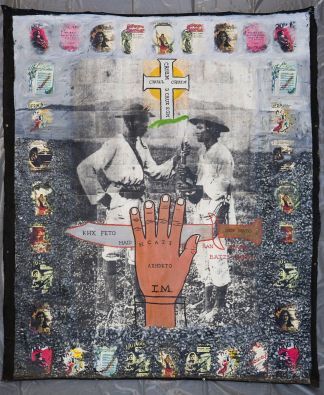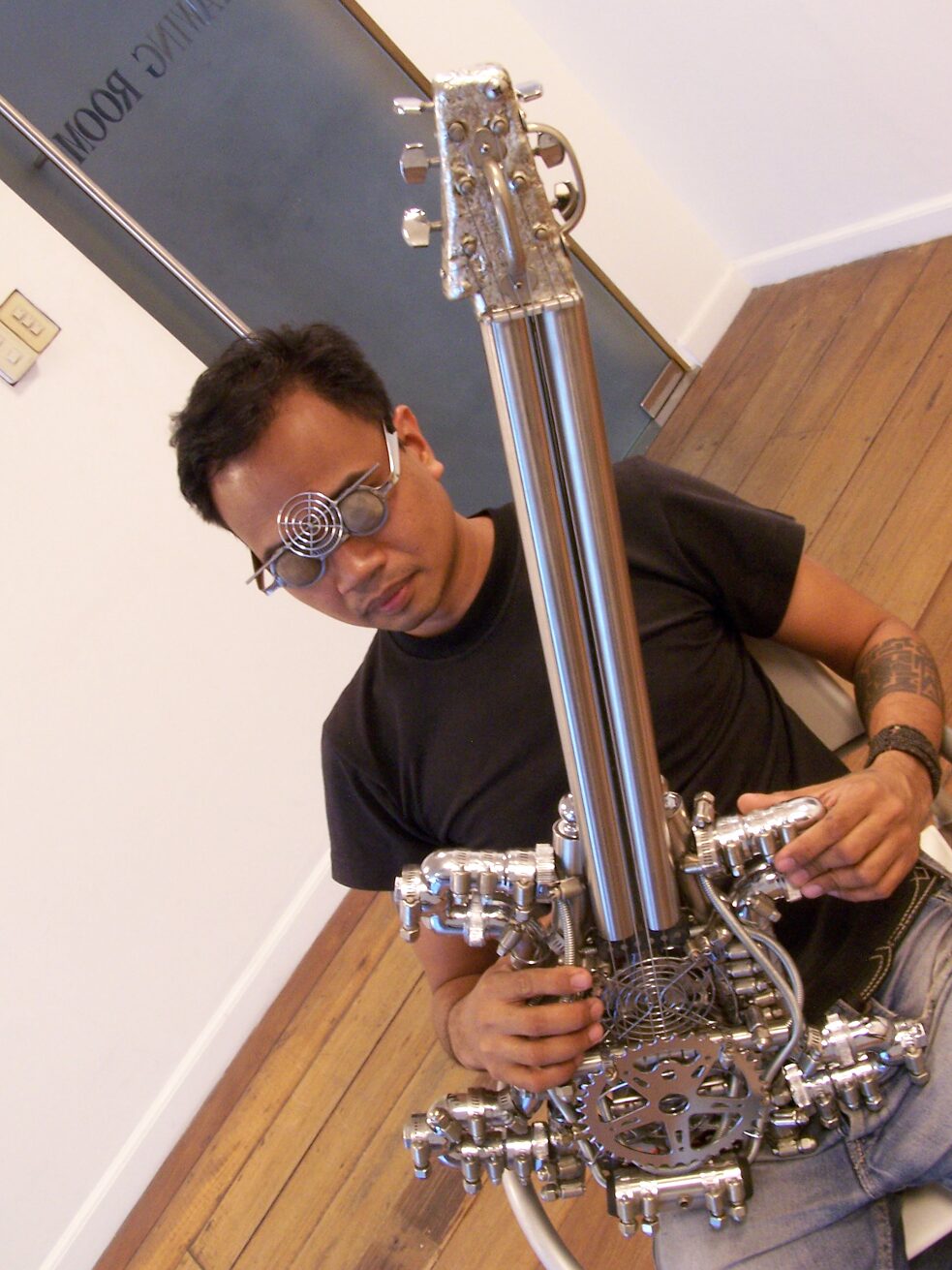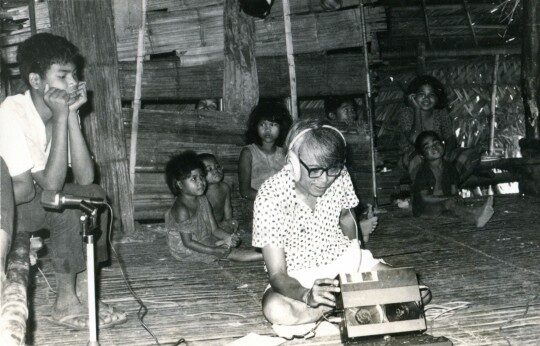
The Bars Of The Bahay Kubo - Part 2
By Tad Ermitaño, 2020Back in the early 1980s, I stumbled onto the Mowelfund Film Institute, which was then in the middle of its heyday of experimental film workshops. I was at the time a refugee from the sciences with a penchant for extreme music, and was immediately attracted to experimental film, which encouraged and unified my seemingly contradictory affinities for the technical and the transcendent. However, while the community in Mowelfund appreciated attempts at radical gestures, screenings of our works would inevitably attract art lovers with more conventional leanings. It was not uncommon to overhear some members of the audience (Filipinos, just to be clear) afterwards saying something to the effect that »Filipinos« didn't like those kinds of films. Or (more tellingly) to hear the films described by some adjectival variant of »Western,« »American,« or »European.«
Low-tech but Soulful
I find Tahimik’s work remarkable for the way it champions and manifests this image of Filipino identity. Tahimik writes the provincial from the inside—in his justly celebrated film, Perfumed Nightmare, he recapitulates something of the cofradias’ vision of just living in rudimentary circumstances. We are enveloped in the protagonist’s interior monologue and eventually see his provincial puzzlement revealed as a kind of childlike wisdom that becomes a vantage from which Tahimik launches a rejection of capitalism, imperialism, and consumerism.In an artistic practice that spans performance, installation, and even architecture, Tahimik has—in both interviews and his art—extensively elucidated on the subject of postcolonial narrative and the need for Filipinos to produce indigenous counternarratives to those produced by the West. A key object in his iconographic arsenal is a prop camera made of rattan and bamboo.
Tahimik has explicitly said that the camera is a metaphor for »Indigenous stories,« stories told by Filipinos about the Philippines. The bamboo camera is clearly an extension of the bahay kubo image, where the bamboo is equivalent to the adjective »Indigenous,« which then modifies the more general noun of the object it forms. Thus, a bamboo house is an indigenous house, and a bamboo camera an indigenous camera; Tahimik’s metaphor for »Indigenous cinema.«
 Multi award-winning filmmaker Kidlat Tahimik with his bamboo camera. | Photo by Art Fair Philippines / Jojo Gloria.
Multi award-winning filmmaker Kidlat Tahimik with his bamboo camera. | Photo by Art Fair Philippines / Jojo Gloria.
But why is bamboo the signifier for »Indigenous?« Why is a bamboo camera »Indigenous« and a steel and glass camera not? After all, the Philippines mines iron and produces both steel and glass, while metal kris and cannons have been forged and cast in the Philippines for hundreds of years. Furthermore (as the film scholar Nick DeOcampo points out) Philippine Cinema is almost as old as Hollywood. It would seem that history would give a steel and glass camera a perfect right to symbolize Indigenous Cinema. It seems clear to me that the answer lies in bamboo acting as a metonym for the bahay kubo, the classic symbol for rough-hewn, improvised rusticity. Tahimik’s bamboo camera reprises the same idea that Amorsolo expressed in the 1950s and which (I argue) twisted the cofradias’ image of spiritual righteousness in poverty by shifting emphasis from righteousness to poverty and its manifestations. In Amorsolo’s paintings, Philippine identity is conceived as essentially rustic, or as I prefer to put it, »essentially low-tech.«“Essentially low-tech is half of a notion of an identity constructed in opposition to the technologically superior colonial master. The full restatement of this version of the cofradias’ image would be something like: low-tech but soulful.
I keep the vernacular and somewhat clumsy neologism of »low-tech« for a number of reasons, chief of which is that it reflects the clumsy, problematic, and temporal nature of what it signifies. »Low-tech« is meaningful only in contrast to »high-tech,« its opposite; and both are, especially in a time of hurtling technological change, moving targets. What is high-tech today is low-tech tomorrow. The category a given piece of technology occupies shifts constantly, defined by context, fashion, popularity, marketing, novelty, and convention.
Philippine identity is conceived as essentially rustic, or as I prefer to put it, »essentially low-tech.«“Essentially low-tech is half of a notion of an identity constructed in opposition to the technologically superior colonial master. The full restatement of this version of the cofradias’ image would be something like: low-tech but soulful.
In one of his diary films, Tahimik expresses anxiety at his eldest son’s decision to study computer programming, worrying that programming is an inappropriate field of study for someone coming from »a Third World country.« The remark put me in mind of Douglas Adams’ tongue-in-cheek distillation of our reactions to technology:
- Anything that is in the world when you’re born is normal and ordinary and is just a natural part of the way the world works.
- Anything that’s invented between when you’re fifteen and thirty-five is new and exciting and revolutionary and you can probably get a career in it.
- Anything invented after you’re thirty-five is against the natural order of things.
Douglas’ deliberately hyperbolic remark essentially summarizes Tahimik’s anxiety and the problem of behind the adjective »low-tech.« Having mastered the technical discipline of celluloid filmmaking, Tahimik expresses anxiety towards the unfamiliar technology of computers. This telling confession exposes »low-tech« simply as »old tech« or (perhaps more accurately) as »familiar tech«: Adams’ »stuff that was in the world before you were born.« However, as Adams goes on to show, the difference between tech that is »normal and ordinary« and tech that is »against the natural order of things« is a difference that constantly shifts.
Still, it seems clear in retrospect that this idea of a Filipino nature and destiny based on what might be called »spiritual« grounds was the conceptual third way, the necessary alternative to the colonial world-view’s binary categories of Student and Master. There is no doubt that this third way was immensely beneficial to the culture and to the country. One can see it underwriting all sorts of cultural initiatives, from the folk-rock of the band Asin to the installations of Roberto Villanueva. From the paintings of Santiago Bose to the scholarly works of Reynaldo Ileto and Reynato Constantino, and (I would argue) even to the avante-garde compositions of Jose Maceda, whose writings explicitly link his use of indigenous instruments to a Filipino authenticity he conceived as rooted in rural areas and »village thinking.« I do not, in other words, mean in any way to denigrate the contribution of this idea to Philippine culture. It was and is an important conceptual achievement, and critical to articulating opposition to colonial narratives. However, it seems clear to me that this idea entails certain logical implications that have produced less than salutary results.
 “Native Song” 1999 oil on canvas with mixed media and colour process prints on paper by Santiago Bose. | Photo is licensed under CC BY 4.0
“Native Song” 1999 oil on canvas with mixed media and colour process prints on paper by Santiago Bose. | Photo is licensed under CC BY 4.0
If Filipino identity is positioned as »essentially low-tech,« then Filipino identity becomes trapped in seeing itself in opposition to all technology that is new and unfamiliar. This position forms the bars of the bahay kubo.
Under this dispensation, the use of anything (currently) deemed »high-tech« appears as improper or as some kind of transgression. This improperness can manifest in any number of ways. The user and his enterprise/work can appear contradictory, false, dishonest, or arrogant. The user can even appear threatening if his enterprise is somehow linked to the idea that the user has decided to break ranks and side with the »First World.« It is in this way that technophobia becomes entailed as an element of national identity. The trap has three consequences that are particularly noxious. The first is that it legitimizes smart-shaming and the denigration of hard work.
If Filipino identity is positioned as »essentially low-tech,« then Filipino identity becomes trapped in seeing itself in opposition to all technology that is new and unfamiliar. This position forms the bars of the bahay kubo.
Rapprochement
However, I do sense that there is something of a sea-change afoot. One of the most visible manifestations of this change is in the burgeoning underground noise scene, where circuit bending and technological repurposing are valorized. The instruments display and valorize, both through their structure and use, acts of »technological disobedience,« to use the elegant and poetically precise phrase of the Cuban artist Ernesto Orozco. The phrase nods to the idea that technology contains embedded messages, many or even most of which consist of commands. In addition to this, the phrase implies that one may exercise one’s agency by violating precisely those commands. It ideologically validates the practice of using »finished objects« as repositories of parts for making other machines, machines that solve problems and fulfill needs in the local present. This is either very close to the opposite of technophobia, or is at least an exorcism of it. Lirio Salvador with some of his homemade devices (glasses, guitar). | Photo by Jing Garcia, 2005
Lirio Salvador with some of his homemade devices (glasses, guitar). | Photo by Jing Garcia, 2005
These corrective tendencies are highly visible in the art and music of Lirio Salvador, one of the pioneers of Filipino Noise, which he called »sound art.« Lirio and his band Elemento (first named Intermidya and then Publiko) were contemporaries of my own media performance band, The Children of Cathode Ray, but did us one better by using instruments Lirio made himself: silver, electrified monstrosities assembled from eating utensils, bicycle parts. and found plumbing. In many of his performances I got the sense that he was enacting a kind of cyborg theater, a fusion of man and machine. One of his performances consisted of organizing a communal cleanup of a local creek, during which he also performed noise. In a telling quote, Lirio once said of his practice that:
It’s all about the merging of my native oriental culture and the present industrial environment that is slowly corrupting my native land.
I am particularly struck by his use of the word “merging,” as it seems to me that the logical development of a Filipino consciousness that was founded (however partially or accidentally) by imagining itself as the opposite of technology MUST eventually make an accomodation—merge—with this essential feature of contemporary life.
In my more self-indulgent moments, I even wonder if this perhaps specifically Filipino development might in the future play a role in deconstructing the founding opposition of Man and Nature that underpins the notion of Technology itself
It seems to me that the logical development of a Filipino consciousness that was founded (however partially or accidentally) by imagining itself as the opposite of technology MUST eventually make an accomodation—merge—with this essential feature of contemporary life.
 Jose Maceda | Photo courtesy of UP Center for Ethnomusicology
Jose Maceda | Photo courtesy of UP Center for Ethnomusicology
I would like to close with a quote from the composer Jose Maceda. The following lines extolling »village thinking« resound with the dangerous (but perhaps historically necessary) first step of conceiving Filipino National Identity as ensconced within the horizon of a low-tech idyll; set against Lirio’s quote however, I feel that it can also be read as prophetic. That is to say, as containing the seed to a wiser, more intentional, and hopefully more sustainable use of technology:
Village thinking is a source of wisdom for modern living and of a more beneficial or philosophical use of technology. It is the view of life to which modern man can look up to in order to extricate himself from the gigantic system of present living which tends to destroy the very essence of man, whose spirit far exceeds what a computer society can possibly give him.